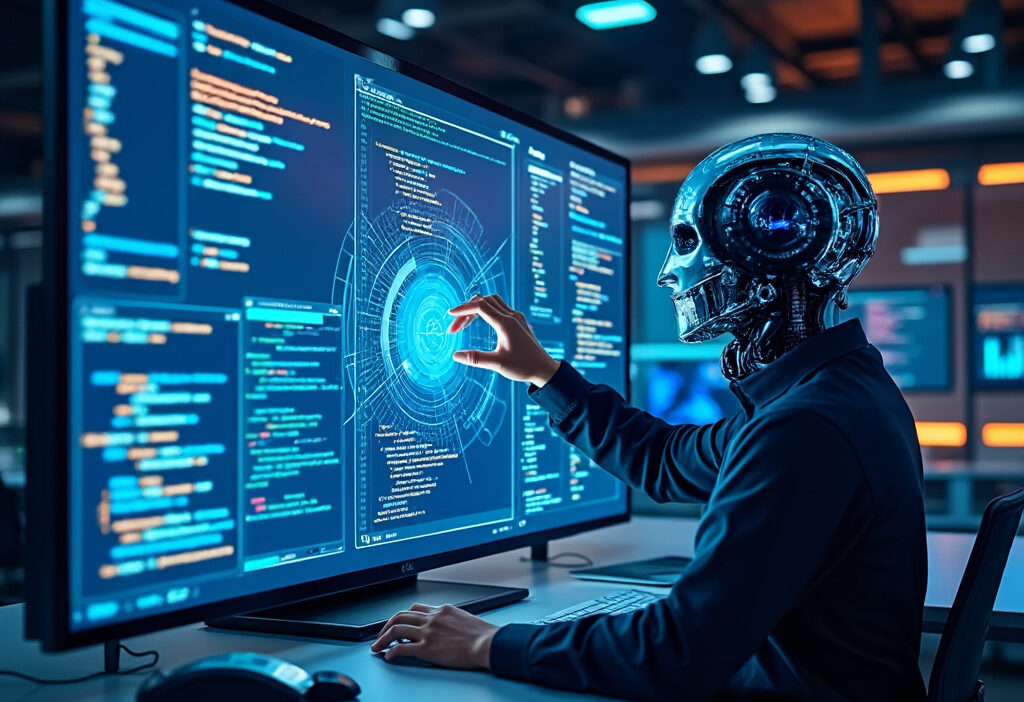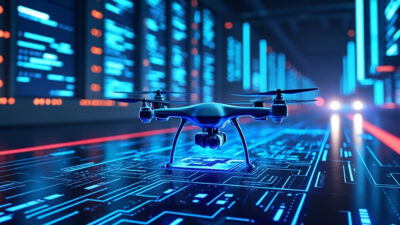Revolutionizing Code How AI is Transforming Software Development in 2025
As we step into 2025, artificial intelligence (AI) is no longer just a tool but a revolutionary force in software development. From automating mundane tasks to predicting code errors before they happen, AI is reshaping how developers write, test, and deploy software. This article delves into the transformative role of AI in the coding world, offering insights into its current applications and future potential.
The Rise of AI in Software Development
The integration of AI into software development has been a gradual but transformative journey, evolving from rudimentary assistance to becoming an indispensable part of the development lifecycle. In the early 2010s, AI’s role was limited to basic tasks like code completion and bug detection, with tools like IntelliSense and static analyzers laying the groundwork. However, the advent of machine learning and neural networks in the mid-2020s marked a turning point, enabling AI to understand context, predict developer intent, and even suggest architectural patterns.
Key milestones include the release of GitHub Copilot in 2021, which leveraged OpenAI’s Codex to provide real-time code suggestions, blurring the line between human and machine-generated code. By 2023, AI had advanced to the point where it could refactor legacy systems autonomously, reducing technical debt for enterprises. The introduction of AI-powered debugging tools like Amazon CodeGuru and DeepCode further cemented AI’s role, offering actionable insights that went beyond traditional linting.
By 2025, AI has shifted from being a supportive tool to a core component of development workflows. Modern AI systems now integrate seamlessly with IDEs, version control, and CI/CD pipelines, acting as collaborative partners rather than mere assistants. They analyze vast repositories of open-source code to recommend optimizations, enforce best practices, and even draft entire modules based on high-level requirements. This evolution has redefined the developer’s role, allowing them to focus on creativity and problem-solving while AI handles the repetitive and error-prone aspects of coding.
The rise of AI in software development has also spurred ethical and governance discussions, particularly around code ownership and bias mitigation. Yet, its undeniable impact on productivity, quality, and innovation ensures that AI will remain at the heart of development processes for years to come.
Automating Code Generation
In 2025, AI-driven code generation has shifted from an experimental novelty to an indispensable part of software development workflows. By leveraging advanced natural language processing (NLP) and machine learning models, AI now interprets human intent with remarkable precision, translating plain English—or even rough sketches—into functional code. This transformation is redefining how developers approach problem-solving, allowing them to focus on high-level architecture while AI handles the tedious implementation details.
Key advancements in AI code generation include:
- Context-aware autocompletion: Tools like GitHub Copilot X and Amazon CodeWhisperer analyze entire codebases to suggest not just syntactically correct snippets but logically coherent functions tailored to the project’s style and requirements.
- Natural language to code: Platforms such as OpenAI’s Codex and Google’s Project IDX enable developers to describe a feature in conversational language (e.g., “create a REST API endpoint for user login”) and receive production-ready code, complete with error handling and optimizations.
- Low-code/No-code democratization: AI-powered tools like Bubble and Retool now generate entire applications from wireframes or flowcharts, bridging the gap between non-technical stakeholders and functional prototypes.
The implications are profound. Junior developers can rapidly upskill by studying AI-generated examples, while seasoned engineers delegate boilerplate code to AI, reserving their expertise for complex algorithmic challenges. However, this shift isn’t without friction. Concerns about code originality, security vulnerabilities in AI-generated logic, and over-reliance on opaque “black box” suggestions persist. Yet, as models grow more transparent and auditable—integrating explainability features—the balance between automation and human oversight is steadily improving.
This evolution sets the stage for the next frontier: AI-enhanced debugging, where the same models that generate code will proactively identify and resolve flaws before they reach production.
Enhancing Debugging with AI
Debugging has long been one of the most time-consuming and frustrating aspects of software development, but AI is changing that in 2025. With the rise of AI-powered debugging tools, developers can now predict, identify, and resolve bugs faster and more accurately than ever before. These tools leverage machine learning models trained on vast repositories of code, historical bug reports, and runtime data to detect anomalies before they escalate into critical failures.
One of the most significant advancements is predictive debugging, where AI analyzes patterns in code behavior to flag potential issues before they manifest. For example, tools like DeepDebug and BugPredict use neural networks to correlate code changes with past bug occurrences, alerting developers to high-risk areas. Unlike traditional debuggers that rely on breakpoints and manual inspection, these systems proactively suggest fixes based on contextual understanding.
Another breakthrough is automated root cause analysis. Modern AI debuggers can trace errors through complex execution paths, isolating the exact line or module responsible. Tools such as AIssistant integrate with IDEs to provide real-time explanations and even generate patches for common bugs, reducing the need for lengthy trial-and-error sessions.
Additionally, AI enhances collaborative debugging. Platforms like CodeSentry use natural language processing to parse bug reports and automatically link them to relevant code sections, streamlining team workflows. By learning from past resolutions, these systems continuously improve their accuracy, making debugging a more efficient and less error-prone process.
As AI continues to evolve, debugging is shifting from a reactive task to a proactive, intelligent process—seamlessly bridging the gap between automated code generation and AI-driven quality assurance.
AI in Code Review and Quality Assurance
AI is reshaping code review and quality assurance (QA) by automating traditionally manual and error-prone processes. In 2025, AI-powered tools are no longer just assistants—they are integral to ensuring code integrity, security, and compliance. These systems leverage machine learning to analyze vast codebases in real-time, identifying errors, vulnerabilities, and deviations from coding standards with unprecedented accuracy.
One of the most significant advancements is AI’s ability to contextually understand code. Unlike static analyzers, modern AI tools interpret intent, detecting logical flaws that humans might overlook. For example, they can flag insecure API usage or subtle race conditions by correlating patterns across repositories. Tools like GitHub’s Copilot X and Amazon CodeGuru now provide automated pull request reviews, suggesting optimizations and even rewriting problematic sections while maintaining the original developer’s style.
Compliance is another area where AI excels. Regulatory requirements like GDPR or HIPAA demand strict adherence, and AI ensures code meets these standards by cross-referencing rules against every commit. It can also enforce team-specific conventions, such as naming schemes or architectural patterns, reducing technical debt.
Security has seen a paradigm shift with AI-driven vulnerability detection. By training on historical breach data, these tools predict potential exploits before they manifest, offering fixes or mitigation strategies. For instance, an AI might detect a SQL injection risk in a seemingly harmless query and recommend parameterized alternatives.
The synergy between AI and QA doesn’t stop at error detection. Continuous integration pipelines now integrate AI to prioritize high-risk changes, accelerating deployments without sacrificing quality. As development environments become more personalized (as explored in the next chapter), AI’s role in code review will further adapt, learning individual preferences while maintaining rigorous oversight. The result? Faster, safer, and more maintainable code—revolutionizing how teams ship software.
Personalized Development Environments
In the rapidly evolving landscape of software development, AI is ushering in a new era of Personalized Development Environments (PDEs), tailored to the unique needs of individual developers. Unlike traditional IDEs, which offer static tools and configurations, AI-driven PDEs dynamically adapt to a developer’s coding style, preferences, and even cognitive patterns. By analyzing historical data—such as keystrokes, debugging habits, and code reuse—these environments optimize workflows in real time, reducing friction and boosting productivity.
For instance, an AI-powered PDE might predict the next block of code a developer intends to write, offering context-aware suggestions that align with their past choices. It could also adjust syntax highlighting, auto-completion speed, or even refactoring recommendations based on the developer’s proficiency level. Some systems go further by integrating biometric feedback, such as eye-tracking or fatigue detection, to suggest breaks or simplify complex tasks when focus wanes.
Beyond individual customization, these environments foster seamless transitions between projects and teams. If a developer switches from a backend to a frontend task, the PDE reconfigures toolchains, libraries, and shortcuts to match the new context. This adaptability minimizes the cognitive load of context-switching, a common productivity killer.
The implications are profound: fewer repetitive tasks, faster onboarding for new hires, and a more intuitive coding experience. As AI continues to refine these environments, the line between tool and collaborator blurs—setting the stage for the next frontier: AI-enhanced collaborative coding, where personalized insights merge with team-wide synergy.
The Role of AI in Collaborative Coding
In 2025, AI has become an indispensable ally in collaborative coding, reshaping how teams work together on complex software projects. Gone are the days of manual merge conflicts and inconsistent coding styles—AI-powered tools now streamline collaboration by automating tedious tasks and ensuring seamless integration of contributions.
One of the most transformative advancements is AI-driven conflict resolution. Modern version control systems, enhanced by machine learning, analyze code changes in real-time, predicting potential merge conflicts before they occur. These systems suggest optimal resolutions, reducing the back-and-forth between developers and accelerating the integration process. For instance, tools like GitHub’s AI-powered Copilot for Teams not only detect syntactic discrepancies but also understand the intent behind code changes, proposing context-aware fixes that align with the project’s architecture.
Beyond conflict resolution, AI fosters consistency across distributed teams. Style enforcement tools, trained on a project’s historical data, automatically adjust contributions to match established conventions—whether it’s indentation, naming schemes, or architectural patterns. This eliminates the need for manual code reviews on trivial matters, allowing developers to focus on logic and innovation.
Real-time collaboration has also evolved. Cloud-based IDEs with embedded AI assistants provide instant feedback, flagging potential issues as developers type. These assistants learn from team interactions, offering personalized suggestions that align with both individual habits and collective goals. For example, if one developer frequently implements a specific algorithm, the AI might recommend optimized variants to teammates working on related features.
As AI continues to refine collaborative workflows, the next frontier lies in predictive analytics—anticipating project bottlenecks before they derail timelines, a topic we’ll explore next.
Predictive Analytics in Project Management
In the fast-evolving landscape of software development, AI-driven predictive analytics is reshaping how teams manage projects, ensuring efficiency and minimizing risks. By leveraging historical data, machine learning models, and real-time insights, AI can forecast project timelines with remarkable accuracy, allowing teams to adjust schedules proactively rather than reactively. This shift from traditional estimation methods—often prone to human bias—to data-driven predictions is reducing delays and optimizing delivery cycles.
Timeline Prediction and Risk Mitigation
AI analyzes past project performance, developer productivity, and external factors like dependencies to generate realistic timelines. Tools like Jira and Asana now integrate AI to flag potential bottlenecks before they escalate, suggesting corrective actions such as reallocating resources or reprioritizing tasks. For instance, if a critical module consistently takes longer than estimated, AI can recommend splitting the work or assigning additional developers.
Resource Allocation and Efficiency
Dynamic resource allocation is another game-changer. AI evaluates team members’ skills, workloads, and even burnout indicators to distribute tasks optimally. Instead of manual assignment, systems automatically match developers to features where they’ll be most effective, balancing speed and quality. This minimizes idle time and prevents overloading key contributors.
Bottleneck Identification
By monitoring code commits, pull requests, and testing cycles, AI detects patterns that signal impending delays—like frequent merge conflicts or testing failures. Early warnings allow teams to address issues before they snowball, maintaining momentum.
As AI becomes integral to project management, its predictive capabilities are not just enhancing efficiency but also fostering a culture of proactive problem-solving. However, this reliance on AI raises questions about transparency and accountability, setting the stage for the ethical challenges discussed next.
Ethical Considerations and Challenges
As AI becomes deeply embedded in software development, ethical concerns and challenges demand urgent attention. While predictive analytics optimizes project management, the reliance on AI introduces risks that could undermine its benefits if left unchecked.
Job displacement remains a pressing issue. AI-powered tools automate coding, debugging, and even architectural design, raising fears that junior developers and traditional coding roles may become obsolete. However, rather than eliminating jobs, AI is reshaping them—demanding new skills in AI oversight, ethical auditing, and hybrid human-AI collaboration. The challenge lies in workforce reskilling and ensuring equitable access to emerging opportunities.
Bias in AI algorithms is another critical concern. AI models trained on historical codebases may perpetuate outdated practices, reinforce security flaws, or even amplify biases present in training data. For instance, AI-generated code might favor certain programming paradigms over others, stifling innovation. Developers must implement rigorous bias detection frameworks and diversify training datasets to mitigate these risks.
Security risks escalate as AI-generated code becomes prevalent. Automated systems might introduce vulnerabilities if they prioritize speed over robustness. Worse, malicious actors could exploit AI tools to generate sophisticated attacks or obfuscated malware. Proactive measures—such as AI-driven security audits and stricter validation protocols—are essential to safeguard software integrity.
Finally, accountability becomes murky when AI contributes to code. Who is responsible for errors—the developer, the AI vendor, or the algorithm itself? Legal and ethical frameworks must evolve to clarify liability and ensure transparency in AI-assisted development.
Balancing innovation with responsibility will define the next era of software engineering. As we look toward future AI advancements, addressing these ethical challenges is not optional—it’s foundational for sustainable progress.
Future Trends AI and Beyond
As AI continues to reshape software development in 2025, the next wave of innovation is already on the horizon. Emerging technologies like quantum computing, neuromorphic hardware, and autonomous AI agents promise to push the boundaries of what’s possible in coding and development. Quantum algorithms, for instance, could revolutionize optimization problems, enabling AI to solve complex software architecture challenges in seconds—tasks that currently take weeks. Meanwhile, neuromorphic chips, designed to mimic the human brain, may allow AI to learn and adapt in real-time, reducing the need for extensive training datasets and making AI-assisted development even more intuitive.
Another trend gaining momentum is the rise of self-evolving code. AI systems are beginning to not only generate but also iteratively improve their own code based on runtime performance metrics. This could lead to software that continuously refines itself, minimizing bugs and optimizing efficiency without human intervention. Additionally, federated learning is enabling collaborative AI models that learn from decentralized data sources while preserving privacy—a game-changer for open-source development and enterprise software alike.
The integration of AI with augmented reality (AR) and virtual reality (VR) is also opening new frontiers. Developers may soon design and debug code in immersive 3D environments, with AI providing real-time suggestions and visualizations. Furthermore, as AI becomes more autonomous, we might see the emergence of AI-driven development ecosystems, where multiple AI agents collaborate to build, test, and deploy software with minimal human oversight.
However, these advancements also raise questions about the role of human developers. Rather than replacing them, AI is likely to shift their focus toward higher-level design, ethics, and creativity—topics explored in the previous chapter. The next section will delve into how developers and organizations can prepare for this rapidly evolving landscape.
Preparing for an AI-Driven Development Future
As AI becomes an integral part of software development, developers and organizations must proactively adapt to stay ahead. The shift toward AI-driven workflows demands a reevaluation of skills, tools, and processes to harness its full potential. Here’s how to prepare for this transformation.
Upskilling for Developers
Developers should focus on mastering AI-assisted tools like GitHub Copilot, Amazon CodeWhisperer, and other AI pair programmers. Understanding prompt engineering—how to effectively communicate with AI models—will be crucial. Additionally, learning to validate and refine AI-generated code ensures quality while maintaining efficiency. Familiarity with machine learning basics can also help in fine-tuning AI tools for specific use cases.
Organizational Readiness
Companies must invest in AI infrastructure, including cloud-based development environments optimized for AI collaboration. Adopting AI-augmented DevOps pipelines can streamline testing, debugging, and deployment. Organizations should also establish governance frameworks to address ethical concerns, bias mitigation, and intellectual property risks associated with AI-generated code.
Process Adaptation
Traditional development cycles will evolve. Agile methodologies should incorporate AI-driven prototyping, where rapid iterations are powered by AI suggestions. Teams must balance automation with human oversight—AI excels at repetitive tasks, but critical thinking and architectural decisions remain human-led.
Cultural Shift
Encouraging a culture of experimentation is key. Developers should be empowered to test AI tools without fear of failure, fostering innovation. Cross-functional collaboration between engineers, data scientists, and product managers will ensure AI solutions align with business goals.
The AI-driven future isn’t about replacing developers but augmenting their capabilities. By embracing these changes, both individuals and organizations can unlock unprecedented efficiency and creativity in software development.

Conclusions
The integration of AI into software development is not just changing how code is written; it’s redefining the very nature of development work. As we’ve explored, AI offers unparalleled efficiencies, from automating routine tasks to enhancing collaboration and predictive analytics. However, embracing this future requires addressing ethical challenges and preparing for continuous learning. The journey of AI in software development is just beginning, and its full potential is yet to be realized.



